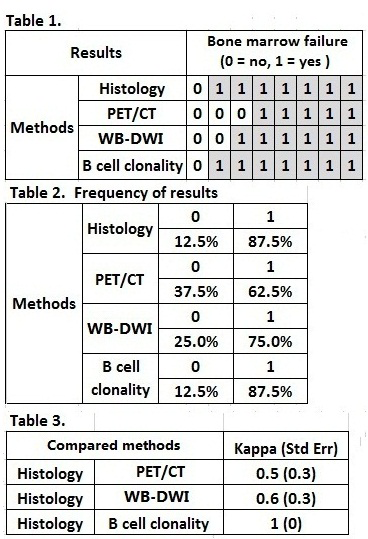BACKGROUND: Follicular lymphoma (FL) is a B-cell tumor, which in most patients is characterized by slow growth and an "indolent" clinical course. In 80% of patients bone marrow is affected, which is a reflection of the pathogenesis of the tumor. The "watch and wait" tactic is a frequently used variant of patient management. For effective therapy, it is necessary to establish the stage of the disease, which requires the examination of the bone marrow (bilateral trepanobiopsy) and the identification of nodal and extranodal lesions (using PET/CT or CT of the whole body). The use of these methods is associated with high radiation exposure and the risk of complications in the intravenous radiopharmaceuticals and contrast agents. Whole body diffusion-weighted magnetic resonance imaging (WB-DWI) makes it possible to detect the burden of the tumor process without the use of contrast agents.
AIM: Assess the capabilities of the WB-DWI method for determining the prevalence of a tumor and the detection of BM lesions in patients with FL.
PATIENTS AND METHODS: The study was conducted during the fourth quarter of 2018 in the National Research Center for Hematology (Moscow), covered 8 patients (3 men and 5 women, with an average age of 53 years). According to the developed design of the study at the time of diagnosis of PL, all patients underwent a WB-MRI study, and then performed (with masking of participants): PET/CT, a histological examination of the bone marrow and the determination of B-cell clonality in bone marrow punctate (using PCR method). The results of the last two examinations were taken as reference (true) estimates for the detection of bone marrow lesions, and compared with the results obtained using the WB-MRI and PET/CT methods. Cohen's kappa statistical coefficient was used to assess the agreement between comparing methods.
RESULTS: All 8 patients had a generalized lesion of the lymph nodes and extranodal foci (stage 4 according to An-Arbor). It was found that the measured diffusion coefficient in the lesions of the BM was 0,5‒0,9 х 10-3 mm/s. Reference tests showed that in 7 out of 8 patients, BM was affected. PET/CT gave two false-negative results, WB-DWI - one false-negative results (Tables 1‒2). Estimates of the prevalence of lesions of the lymph nodes and extranodal foci by WB-DWI and PET/CT were consistent with the accuracy of the methods. Estimates of the extent of lymph node involvement and extranodal lesions using WB-DWI and PET/CT were coincided with the accuracy of the methods errors.
CONCLUSION: The results (Table 3.) of this exploratory research show that the WB-DWI method reveals a bone marrow damage not worse than the PET/CT method: kappa coefficient for WB-DWI was 0.6 and for PET/CT ‒ 0,5, respectively (due to the small sample size, strict statistical significance was not reached). WB-DWI allows you to quickly and informatively determine the affected areas and the involvement of BM, and thereby establish the stage of the disease. The results suggest an opportunity (along with the PET/CT method) to use the WB-DWI method as well.
No relevant conflicts of interest to declare.
Author notes
Asterisk with author names denotes non-ASH members.


